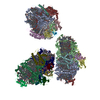+ Open data
Open data
- Basic information
Basic information
| Entry | Database: EMDB / ID: EMD-4095 | |||||||||
|---|---|---|---|---|---|---|---|---|---|---|
| Title | Negative stain EM-structure of Checkpoint point kinase Tel1 | |||||||||
 Map data Map data | Negative stain structure of dimeric Tel1. | |||||||||
 Sample Sample |
| |||||||||
| Biological species |   Saccharomyces cerevisiae S288c (yeast) Saccharomyces cerevisiae S288c (yeast) | |||||||||
| Method |  single particle reconstruction / single particle reconstruction /  negative staining / Resolution: 22.7 Å negative staining / Resolution: 22.7 Å | |||||||||
 Authors Authors | Darbari VC / Sawicka M / Wanrooij PH / Hailemariam S / Zhang X / Burgers PM | |||||||||
 Citation Citation |  Journal: J Biol Chem / Year: 2016 Journal: J Biol Chem / Year: 2016Title: The Dimeric Architecture of Checkpoint Kinases Mec1ATR and Tel1ATM Reveal a Common Structural Organization. Authors: Marta Sawicka / Paulina H Wanrooij / Vidya C Darbari / Elias Tannous / Sarem Hailemariam / Daniel Bose / Alena V Makarova / Peter M Burgers / Xiaodong Zhang /   Abstract: The phosphatidylinositol 3-kinase-related protein kinases are key regulators controlling a wide range of cellular events. The yeast Tel1 and Mec1·Ddc2 complex (ATM and ATR-ATRIP in humans) play ...The phosphatidylinositol 3-kinase-related protein kinases are key regulators controlling a wide range of cellular events. The yeast Tel1 and Mec1·Ddc2 complex (ATM and ATR-ATRIP in humans) play pivotal roles in DNA replication, DNA damage signaling, and repair. Here, we present the first structural insight for dimers of Mec1·Ddc2 and Tel1 using single-particle electron microscopy. Both kinases reveal a head to head dimer with one major dimeric interface through the N-terminal HEAT (named after Huntingtin, elongation factor 3, protein phosphatase 2A, and yeast kinase TOR1) repeat. Their dimeric interface is significantly distinct from the interface of mTOR complex 1 dimer, which oligomerizes through two spatially separate interfaces. We also observe different structural organizations of kinase domains of Mec1 and Tel1. The kinase domains in the Mec1·Ddc2 dimer are located in close proximity to each other. However, in the Tel1 dimer they are fully separated, providing potential access of substrates to this kinase, even in its dimeric form. | |||||||||
| History |
|
- Structure visualization
Structure visualization
| Movie |
 Movie viewer Movie viewer |
|---|---|
| Structure viewer | EM map:  SurfView SurfView Molmil Molmil Jmol/JSmol Jmol/JSmol |
| Supplemental images |
- Downloads & links
Downloads & links
-EMDB archive
| Map data |  emd_4095.map.gz emd_4095.map.gz | 315.9 KB |  EMDB map data format EMDB map data format | |
|---|---|---|---|---|
| Header (meta data) |  emd-4095-v30.xml emd-4095-v30.xml emd-4095.xml emd-4095.xml | 12.8 KB 12.8 KB | Display Display |  EMDB header EMDB header |
| FSC (resolution estimation) |  emd_4095_fsc.xml emd_4095_fsc.xml | 4.3 KB | Display |  FSC data file FSC data file |
| Images |  emd_4095.png emd_4095.png | 59.4 KB | ||
| Archive directory |  http://ftp.pdbj.org/pub/emdb/structures/EMD-4095 http://ftp.pdbj.org/pub/emdb/structures/EMD-4095 ftp://ftp.pdbj.org/pub/emdb/structures/EMD-4095 ftp://ftp.pdbj.org/pub/emdb/structures/EMD-4095 | HTTPS FTP |
-Related structure data
- Links
Links
| EMDB pages |  EMDB (EBI/PDBe) / EMDB (EBI/PDBe) /  EMDataResource EMDataResource |
|---|
- Map
Map
| File |  Download / File: emd_4095.map.gz / Format: CCP4 / Size: 3.8 MB / Type: IMAGE STORED AS FLOATING POINT NUMBER (4 BYTES) Download / File: emd_4095.map.gz / Format: CCP4 / Size: 3.8 MB / Type: IMAGE STORED AS FLOATING POINT NUMBER (4 BYTES) | ||||||||||||||||||||||||||||||||||||||||||||||||||||||||||||
|---|---|---|---|---|---|---|---|---|---|---|---|---|---|---|---|---|---|---|---|---|---|---|---|---|---|---|---|---|---|---|---|---|---|---|---|---|---|---|---|---|---|---|---|---|---|---|---|---|---|---|---|---|---|---|---|---|---|---|---|---|---|
| Annotation | Negative stain structure of dimeric Tel1. | ||||||||||||||||||||||||||||||||||||||||||||||||||||||||||||
| Voxel size | X=Y=Z: 4.64 Å | ||||||||||||||||||||||||||||||||||||||||||||||||||||||||||||
| Density |
| ||||||||||||||||||||||||||||||||||||||||||||||||||||||||||||
| Symmetry | Space group: 1 | ||||||||||||||||||||||||||||||||||||||||||||||||||||||||||||
| Details | EMDB XML:
CCP4 map header:
| ||||||||||||||||||||||||||||||||||||||||||||||||||||||||||||
-Supplemental data
- Sample components
Sample components
-Entire : Tel1 protein
| Entire | Name: Tel1 protein |
|---|---|
| Components |
|
-Supramolecule #1: Tel1 protein
| Supramolecule | Name: Tel1 protein / type: complex / ID: 1 / Parent: 0 |
|---|---|
| Source (natural) | Organism:   Saccharomyces cerevisiae S288c (yeast) Saccharomyces cerevisiae S288c (yeast) |
| Recombinant expression | Organism:   Saccharomyces cerevisiae (brewer's yeast) / Recombinant strain: BJ2168 / Recombinant plasmid: pBL602 Saccharomyces cerevisiae (brewer's yeast) / Recombinant strain: BJ2168 / Recombinant plasmid: pBL602 |
| Molecular weight | Theoretical: 640 KDa |
-Experimental details
-Structure determination
| Method |  negative staining negative staining |
|---|---|
 Processing Processing |  single particle reconstruction single particle reconstruction |
| Aggregation state | particle |
- Sample preparation
Sample preparation
| Concentration | 0.1 mg/mL | ||||||||||||||||||||||||||||||
|---|---|---|---|---|---|---|---|---|---|---|---|---|---|---|---|---|---|---|---|---|---|---|---|---|---|---|---|---|---|---|---|
| Buffer | pH: 7.4 Component:
| ||||||||||||||||||||||||||||||
| Staining | Type: NEGATIVE / Material: 2% Uranyl Acetate | ||||||||||||||||||||||||||||||
| Grid | Model: TAAB / Material: COPPER / Mesh: 200 / Support film - Material: CARBON / Support film - topology: CONTINUOUS / Pretreatment - Type: GLOW DISCHARGE / Pretreatment - Atmosphere: AIR |
- Electron microscopy
Electron microscopy
| Microscope | FEI/PHILIPS CM200FEG |
|---|---|
| Electron beam | Acceleration voltage: 200 kV / Electron source:  FIELD EMISSION GUN FIELD EMISSION GUN |
| Electron optics | C2 aperture diameter: 100.0 µm / Illumination mode: SPOT SCAN / Imaging mode: BRIGHT FIELD Bright-field microscopy / Cs: 2.7 mm / Nominal defocus max: 4.0 µm / Nominal defocus min: 1.4 µm / Nominal magnification: 38000 Bright-field microscopy / Cs: 2.7 mm / Nominal defocus max: 4.0 µm / Nominal defocus min: 1.4 µm / Nominal magnification: 38000 |
| Image recording | Film or detector model: TVIPS TEMCAM-F416 (4k x 4k) / Number grids imaged: 1 / Average exposure time: 1.0 sec. / Average electron dose: 5.0 e/Å2 |
 Movie
Movie Controller
Controller












